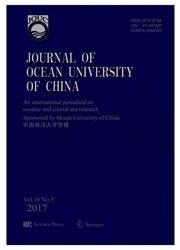

 中文摘要:
中文摘要:
To explore the distribution and composition of phytoplankton community and their responses to environmental changes, summer net-collected phytoplankton and physicochemical parameters in the Hangzhou Bay during 2004–2010 were investigated. A total of four phyla and 84 species were identified, including 67 diatom and 12 dinoflagellate species. The dominant species con- stantly consisted of the diatoms, although the dominance of dinoflagellate and cyanobacteria increased recently. Due to great spa- tio-temporal variations in environmental factors(salinity, suspended solids, and nutrient concentration), significant heterogeneities in community compositions among different years and subregions(inner and middle sections, and bay mouth) were found based on the analyses of multidimensional scaling and similarity. Canonical correspondence analysis showed that salinity and Si/N were the main variables associated with algal assemblage. Compared with the historical data since the 1980 s, eutrophication(N, P, and N/P increased with decreasing Si/N) was exacerbated drastically. Moreover, climatic forcing and human activities resulted in a series of physical alterations, including sediment retention, temperature increase, and salinity decrease as well as reduction in water exchanges. All these changes induced obvious increases in cell density and Chl-a while decreases in species diversity and diatom-dinoflagellate ratio as well as the shifting of dominant species. Therefore, the long-term phytoplankton variations were closely related to anthropogenic and climatic perturbations in the Hangzhou Bay.
 英文摘要:
英文摘要:
To explore the distribution and composition of phytoplankton community and their responses to environmental changes, summer net-collected phytoplankton and physicochemical parameters in the Hangzhou Bay during 2004-2010 were investigated. A total of four phyla and 84 species were identified, including 67 diatom and 12 dinoflagellate species. The dominant species constantly consisted of the diatoms, although the dominance of dinoflagellate and cyanobacteria increased recently. Due to great spatio-temporal variations in environmental factors (salinity, suspended solids, and nutrient concentration), significant heterogeneities in community compositions among different years and subregions (inner and middle sections, and bay mouth) were found based on the analyses of multidimensional scaling and similarity. Canonical correspondence analysis showed that salinity and Si/N were the main variables associated with algal assemblage. Compared with the historical data since the 1980s, eutrophication (N, P, and N/P increased with decreasing Si/N) was exacerbated drastically. Moreover, climatic forcing and human activities resulted in a series of physical alterations, including sediment retention, temperature increase, and salinity decrease as well as reduction in water exchanges. All these changes induced obvious increases in cell density and Chl-a while decreases in species diversity and diatom-dinoflagellate ratio as well as the shifting of dominant species. Therefore, the long-term phytoplankton variations were closely related to anthropogenic and climatic perturbations in the Hangzhou Bay.
 同期刊论文项目
同期刊论文项目
 同项目期刊论文
同项目期刊论文
 Responses of summer phytoplankton community to drastic environmental changes in the Changjiang (Yang
Responses of summer phytoplankton community to drastic environmental changes in the Changjiang (Yang Dynamic changes in phytoplankton community structure after thermal shock and chlorination in a subtr
Dynamic changes in phytoplankton community structure after thermal shock and chlorination in a subtr Variations of summer phytoplankton community related to environmental factors in a macro-tidal estua
Variations of summer phytoplankton community related to environmental factors in a macro-tidal estua Summer nutrient dynamics and biological carbon uptake rate in the Changjiang River plume inferred us
Summer nutrient dynamics and biological carbon uptake rate in the Changjiang River plume inferred us 期刊信息
期刊信息
